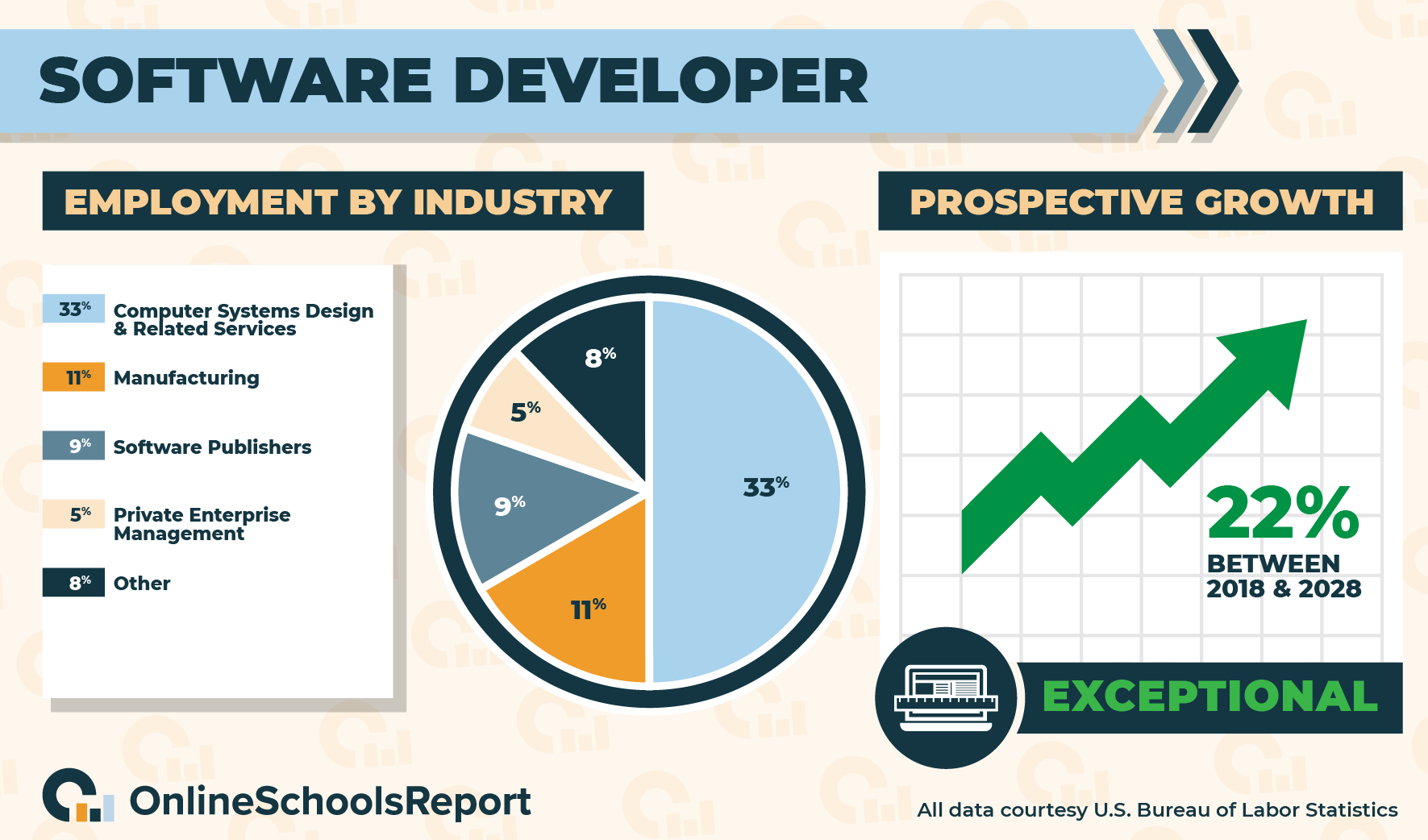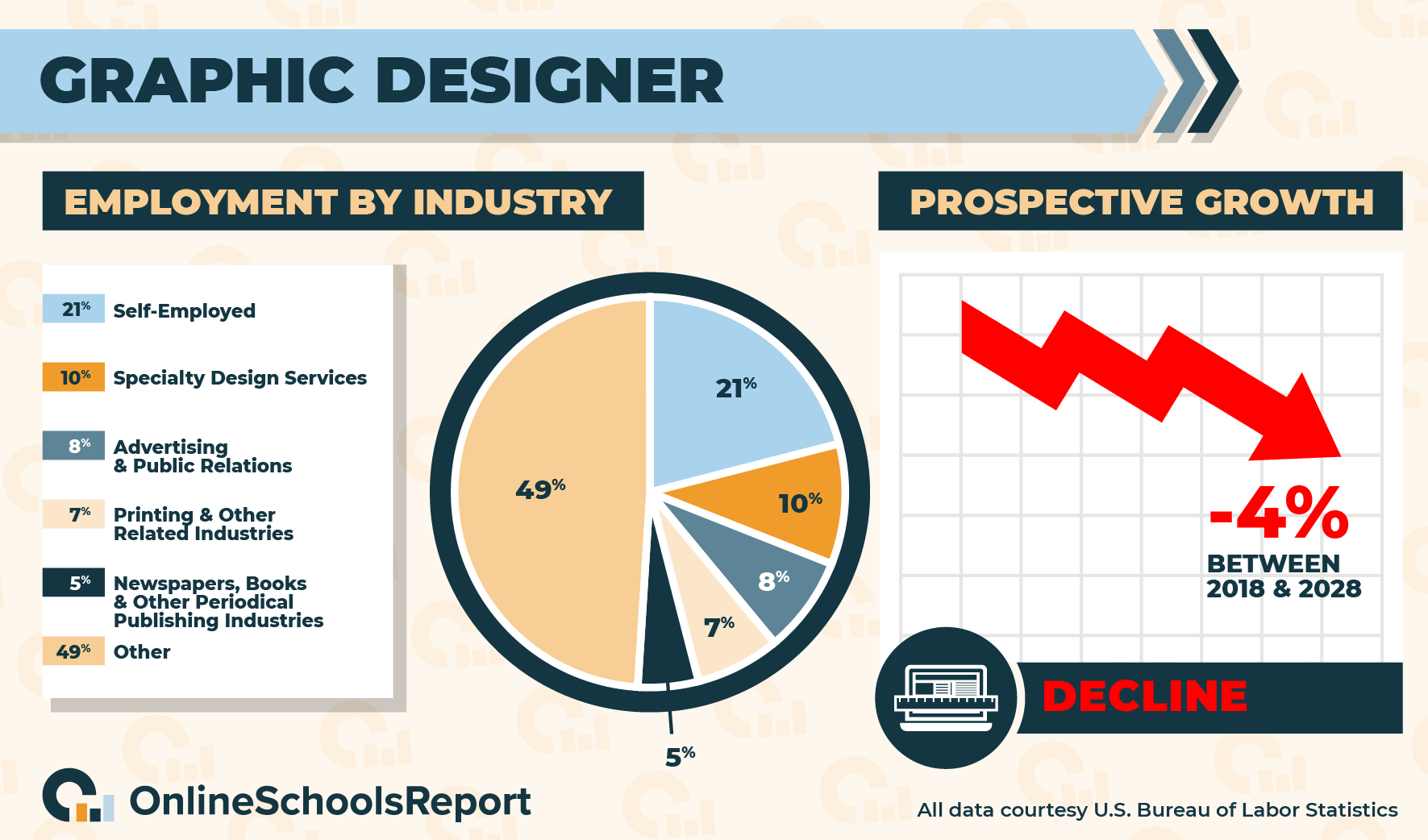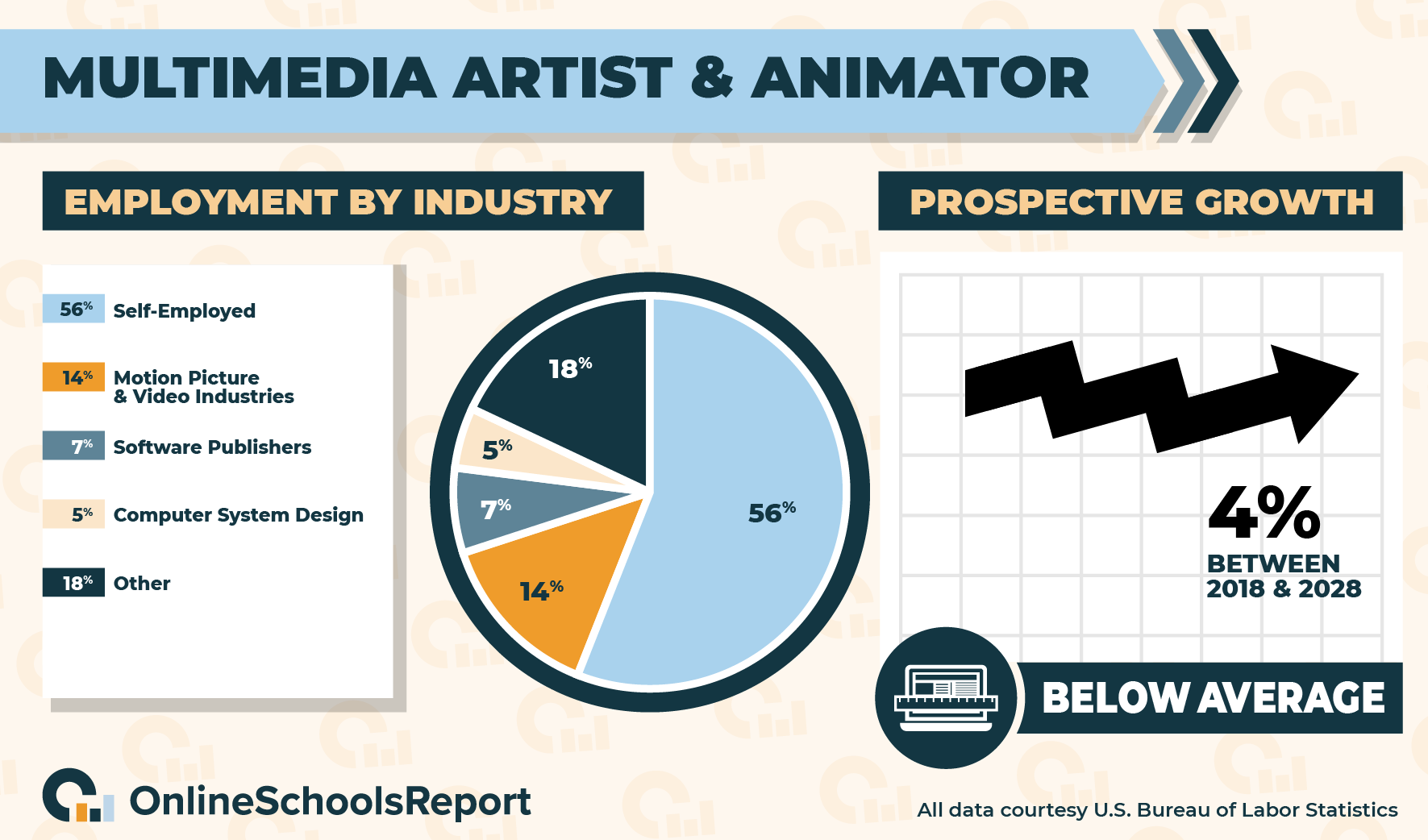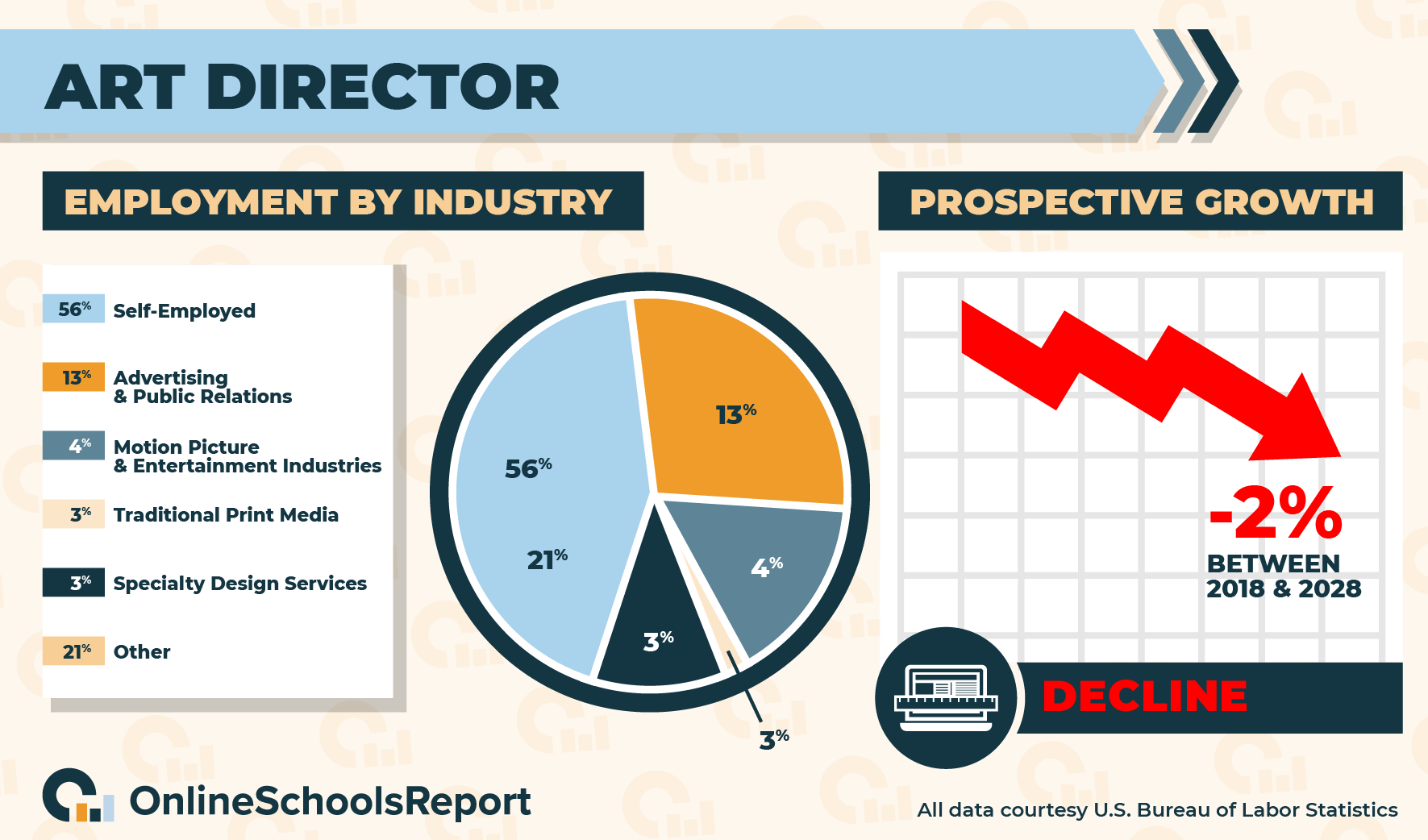We live in a digitally connected world, where almost any good or service is available from the palm of our hand. Our entertainment also lives online: from music and movies to books, magazines, and breaking news.
Behind each different service is a website, and behind each and every website is a web developer, working to ensure that our interactions with the Internet are seamless, satisfying, and secure.
Ready to join an industry of the future? This degree and career guide to web development will tell you how.
What Is Web Development?

As we all know, everyone has a website, from the dentist up the street to the most successful Fortune 500 companies. And each one of these websites began with a web developer.
In their work, web developers take the plan and vision for a website put forth by a web designer or business owner and turn it into a reality, the end result being a fully functioning, easy to use, and secure website or mobile app.
However, not all web developers are the same. There are front-end web developers, who build the visible web interface. But there are also back-end web developers, who care for the parts of the website that are “under the hood.” And then there are full stack web developers, who have the skills and experience to handle it all.
Each of these specialties requires mastering its own set of programming languages, as well as its own educational path.
But don’t worry, we’ll tell you more about that later on. For now, let’s hear from someone who turned a web development degree into a fruitful and fulfilling career.
Pauline Orr of the web design and content development site Pink Pursuits graduated from Tulane University with a bachelor’s degree in web development in 2015.
“In web development, you will have options to go into different industries, work remotely and travel, or for an exciting agency,” Orr tells Online Schools Report.
“It’s a career that is always evolving,” she says, “with a lot of different specialties to go into. With the world becoming more and more virtual, the demand for developers will only grow.”
As Orr hinted at, there is a full range of degrees available in web development. From professional certifications to associate, bachelor’s, master’s, and even doctoral-level degrees. Each one leads to a whole set of exciting career opportunities.
Professional certifications aren’t commonly required by web development employers, though it is possible to become certified in specific web development software and programming languages.
Highly sought-after web design language certifications include Amazon Web Services Associate Level Certified Developer, or the Oracle Application Express Developer Certified Expert, to name just a couple.
To learn more, look for important professional organizations such as the World Organization of Webmasters, the International Web Association, and the Association of Web Design Professionals.
In our next section, we’ll take a closer look at a few exciting jobs made possible by a degree in web development. Let’s get started.
See Also: How Hard is it to Get a Job in Computer Science?
Careers in Web Development
Listed below are just a few of the many jobs made possible by a degree in web development. Web development degrees also qualify graduates to work as computer programmers, hardware developers, and any number of other highly sought after positions in the field of computer science.
| Job Title | Approx. # Years of Education | Average Annual Salary |
| Software Developer | 4 | $107,510 |
| Graphic Designer | 4 | $52,110 |
| Multimedia Artist and Animator | 4 | $75,270 |
| Information Security Analyst | 4 | $99,730 |
| Art Director | 4 | $94,220 |
All salary data is courtesy U.S. Bureau of Labor Statistics Occupational Outlook Handbook.
Software Developer

The world runs on websites these days, though software and mobile apps are also a big part of our digital age. It makes sense then that many of the skills taught in a web development degree program are easily translatable to a career in software development.
The process of software development is very similar to the process of web development. First, the software developer analyzes the needs of the end-user. The developer then builds, designs, and tests software to fulfill those needs, gathering input and feedback from the customer or client along the way.
Software developers must also map out how each piece of the software functions and works together. This helps programmers, with whom software developers closely collaborate, understand the piece of software and the end goal of the project.
Once the project is complete, software developers continue monitoring the product to ensure functionality and that all parts of the software are working seamlessly.
Software developers may also create updates to preexisting software and systems, documenting every step of the development process for future upgrades and software maintenance.

Those in this line of work make on average a little more than $107,000 a year, according to the Bureau of Labor Statistics. There are approximately 1.5 million software development jobs in the U.S. That number is expected to grow at a rate of 22% in the decade spanning 2019–2029, which is about four times the national average, according to the BLS.
What’s clear is that there is no shortage of work opportunities in software development.
Data from the Bureau of Labor Statistics (BLS) also states that a bachelor’s degree is the minimum educational requirement to work as a software developer, though advanced degrees may increase job opportunities and income potential. Work experience in software development is also desirable for many employers.
Data from the BLS also states that 33% of all software developers work in computer systems design and related services, while 11% work in manufacturing. Following that, 9% work for software publishers, and 5% work in private enterprise management.
States with strong levels of employment for software developers include California and Texas, according to the BLS.
Graphic Designer

Front-end software development is all about the graphical interface, controlling what the user sees and how they interact with the product. This makes visual communication skills, like graphic design, an important part of the skill set for any web developer. This can lead to digital art and graphic design work outside the context of web development.
Graphic designers work closely with clients and art directors to fully immerse themselves in the details of the project, from beginning to end. This includes the color palette chosen for the project, as well as the typeface, logo, and other important aesthetic considerations.
Graphic designers then use layout, digital design, and illustrating software to make these plans a reality, seeking approval for elements like logos and original illustrations through constant progress updates with both clients and supervising art directors.
They must then incorporate any changes or revisions as well as correct any errors pointed out at this point in the process.

Graphic designers make a bit more than $52,000 a year on average, according to the Bureau of Labor Statistics, and a bachelor’s degree is most often the minimum educational requirement for a graphic designer. Data from the BLS also states there are just about 282,000 graphic design jobs in the U.S.
That number, though, is expected to decrease at a rate of 4% in the years ranging 2019–2029, making it a competitive job market going forward, which puts degrees like web development at even more of a premium.
The BLS also states that 21% of all graphic designers are self-employed. That’s while 10% work in specialty design services. Following that, 8% work in industries like advertising and public relations, and 7% work in printing and other related industries. The final 5% work for newspapers, books, and other periodical publishing industries.
Good states to live for graphic designers, according to the BLS, include California and New York.
Multimedia Artists and Animators

Similar to graphic designers, multimedia artists and animators use technology to create motion graphics and other kinds of interactive artwork. This work then gets used in a variety of different kinds of media, including but not limited to websites, movies, and video games.
Multimedia artists and animators tend to specialize their skills. Whether that’s in movies and video games, television shows, or computer-generated images (CGI) common in many big-budget blockbuster films. These are sometimes called “special effects.”
Given the computer-based nature of the work, there are many easily transferable-skills from web development to multimedia art and animation.
In the job, multimedia artists and animators work frequently within teams of other animators and artists. They also perform research to render their work as realistically as possible. They may edit animation and effects based on feedback from clients, as well as other animators, directors, art directors, and producers.
Job advancement opportunities within the field of multimedia art and animation include art director, director, and even producer.

Artists and animators of this sort make about $75,000 a year on average, according to the Bureau of Labor Statistics, and there are just about 68,000 jobs in the U.S. That number is expected to grow at a rate of 4% in the years ranging from 2019–2029. That’s right in line with the expected growth for many other professions.
Also according to the BLS, 56% of all multimedia artists and animators are self-employed. Following that, 14% work in the motion picture and video industries. An additional 7% work for software publishers, while 5% work in computer system design.
A bachelor’s degree is usually the minimum educational requirement to work in this industry. Additional professional certification is rarely required by an employer. States with strong employment numbers for multimedia artists and animators include California and New York.
Information Security Analyst

The digital world faces threats every second, and with more and more of our personal information on the web, the job of an information security analyst becomes even more important. A degree in web development is a great place to get into this line of work.
Serving as the first line of defense against hackers, information security analysts constantly monitor computer networks for any breaches of security. IT analysts are also in charge of installing network firewalls and data encryption software. Once a violation is detected, an information security analyst must then investigate and solve the issue.
These analysts may also simulate an attack to expose weak points in the network before they can be exploited, staying on top of the latest and most up-to-date network security measures. They also develop an overall and comprehensive security policy for their clients.
This policy can include reporting all security threats to superiors as well as a plan to enhance security protocols and best practices going forward. Information security analysts may also provide some desktop support as individuals install new software or otherwise update their workstations.

Information security analysts make just a bit less than $100,000 a year on average, according to the Bureau of Labor Statistics. There are also about 131,000 jobs in the U.S. and that number is expected to grow by an astonishing rate of 31% in the years spanning 2019–2029, roughly six times the national average!
Also according to the BLS, 26% of all information and security analysts design computer systems. Following that, 18% work in the finance and insurance industry, and 9% work in business management. That’s while 8% work in information technology, and the final 6% work in administrative and other support services.
BLS data also states that a bachelor’s degree in a computer-related major like web development is the minimum educational requirement to become an information security analyst. Many information security analysts begin their careers as network or computer systems administrators, and the Certified Information Systems Security Professional (CISSP) designation is common in the field.
Good states to live in for information security analysts, according to the BLS, include Virginia and Texas.
Art Director

In their work, art directors marry the virtual and physical space, applying principles of great design and aesthetics to web design, digital content, and other kinds of traditional media. This means behind every font, color, logo, or illustration in a movie, TV show, or website, there’s the trained and meticulous eye of an art director.
In other words, art directors handle all elements of visual representation related to a project. Their responsibility is the overall aesthetic, which is developed in collaboration with clients, directors, producers, and other interested parties. This can include photography, animation, color palettes, and typography.
As well as a background in art and design, this makes a web development degree a great choice for an aspiring art director.
Art directors also manage teams of other designers. Other tasks involve approving graphical elements developed in the design process, often in conjunction with clients, directors, and producers. Budgets and project timelines are also the responsibility of an art director, as can be presenting the work to clients for approval.

According to the Bureau of Labor Statistics, a bachelor’s degree is the most common minimum educational requirement to become an art director. These degrees come from a variety of subjects, but they’re most often related to art, design, or a computer science subject like web development.
Some professional organizations related to art and design include the American Institute of Graphic Arts (AIGA) and the Computing Machinery’s Special Interest Group on Graphics and Interactive Techniques (ACM SIGGRAPH). While these organizations provide great opportunities for networking, postsecondary certification is rarely required in the art and design industry.
Data from the BLS also states that over half of all art directors, or 56%, are self-employed. Following that, 13% find work in advertising and public relations. That’s while an additional 4% work in the motion picture and entertainment industries, including web development. An additional 3% work in traditional print media. The final 3% work in specialty design services.
Data from the BLS also states the average annual salary for any art director is roughly $94,000. Also according to the BLS, there are a little more than 100,000 art director positions in the U.S. Unfortunately, that number is expected to decline at a rate of 2%, making it a competitive job market.
Web Development Degrees
As can be seen, a degree in web development can lead to any number of exciting and rewarding careers. Get your start in web development with any one of the great degree options outlined below.
Associate Degree in Web Development

An associate degree in web development is the best starting point for anyone just beginning their educational career, or for those interested in joining the workforce as quickly as possible.
Due to the vocational nature of these programs, many feel they’re the best choice for their desired career outcome. That’s because these degrees, which are offered at technical schools as well as junior colleges and community colleges, provide the hands-on skills required for entry-level work in the field of web development.
Many who graduate go on to start their own web development business or consulting service. Other job opportunities provided by associate degrees include graphic designer, web developer, and database design.
However, many students choose an associate degree simply to save time and money on the first two years of their four-year bachelor’s degree. That’s because more advanced degrees are often required for career advancement and to increase earning potential in the web development industry.
Common coursework in a web development associate degree program, whether that’s an Associate of Science (AS), or a non-transferable Associate of Applied Science (AAS), can include the fundamentals of IT, application development, and web design.
A high school diploma or equivalent with transcripts is a prerequisite for all associate degree programs. The minimum GPA requirement is most often 2.0, but this can vary between programs. SAT or ACT scores may also be required.
Most associate degree programs require about 60 college credits as a condition of graduation. That’s about 20 college courses, and it takes many students about two years to reach this milestone.
Bachelor’s Degree in Web Development

A Bachelor of Science (BS) degree in Web Development is the next common step for educational development in web development.
Building on the foundation built in an associate degree program, a bachelor’s degree program will move from the vocational to the theoretical, qualifying a graduate to work in positions of management and leadership.
Web development majors often go on to work as information systems managers, in the upper-levels of software development, as a computer systems analyst, or any number of tech or computer science-based careers.
Common coursework in a bachelor’s degree program will include many computer science-related topics, like internet systems architecture, Javascript, and computer systems security. General education courses are also usually required.
Additional certifications are also common for web developers interested in specializing in powerful coding languages, such as The Javascript Developer Developer Certificate.
A high school diploma or equivalent with transcripts is a prerequisite for any bachelor’s degree program. The minimum GPA is most often 2.0, though this varies between programs. ACT and SAT scores may also be required.
As mentioned before, many students transfer credits earned in an associate degree program in web development or a related computer science topic.
Bachelor’s degree programs are usually offered in-person, though many are now offered completely online, or in a hybrid model. Online options are sometimes more affordable than their traditional in-class equivalent.
Roughly 120 credits are required to complete most bachelor’s degrees. That’s typically about 40 college courses, which takes most students about four years to accomplish this benchmark.
Following graduation, many students go on to earn graduate-level degrees in a wide variety of majors related to computer science.
Master’s Degree in Web Development

Following a bachelor’s degree, a Master of Science (MS) degree is the next option available for those looking to continue their education in web development.
A graduate from a master’s degree program in web development will be fluent in multiple programming languages, such as Javascript, HTML5, CSS, and HTTP, among others.
They will also be competent in server design and other aspects of a fully functioning website that’s also safe, secure, and easy to use. A master’s degree also qualifies most graduates to teach at the college or university level.
Those enrolled in a master’s degree program in web development should expect classwork in server development, web analytics, data mining, and much more, depending on the specific focus of your program.
Master’s degree programs also require the completion of a terminal thesis as a condition for graduation, involving new insight and rigorous research in the subject. This thesis will be developed in conjunction with a faculty advisor.
A bachelor’s degree with transcripts is a prerequisite for any master’s degree program. Web development master’s degree programs, however, will accept degrees in a subject outside web development, so long as certain prerequisites are satisfied. GRE or GMAT test scores may also be required.
Many master’s degree programs consist of between 12 and 18 college courses. That’s 36 and 54 credits or 90 quarter credits. This takes most students about two years to complete.
These degrees are offered in the traditional classroom setting, in a hybrid model, or completely online. Most are designed to accommodate the schedules of professionals who may already be working in web development.
Post-graduation, many go on to earn designations like their Google Developers Certification, Adobe Web Certification, and Microsoft Certified Solutions Developer.
Doctorate Degree in Web Development

Interested in pushing the boundaries of research in web development? Continue your education with a PhD or Doctorate in Computer Science with an emphasis in web development.
There are many computer science-related PhD programs applicable to the interests of a web developer. That list includes degrees like Doctor of Information Technology, PhD in Computer Science Technology, PhD in Network Science, or a PhD in Computer Science.
PhDs are academic degrees, prioritizing thorough, comprehensive, and original research, while doctorate degrees are more professional in nature, emphasizing the application of research through fieldwork and practicums.
These degrees may help a graduate move into the upper levels of management or to work for the government. However, most pursue doctoral-level degrees in order to teach and conduct research at the college or university level. Degrees of this nature are rarely required as a condition of employment outside of academics.
Examples of classes taught in a PhD in Web Development program can include qualitative and quantitative research, preparing a thesis, and econometrics, among many other topics.
A master’s degree with transcripts is a prerequisite in a computer science-related major like web development. Letters of recommendation or a statement of personal intent may also be required.
The minimum GPA requirement is most often 3.0, but this can vary between programs. GRE and GMAT scores may also be required.
Some PhD programs consist of as little as 58 or as many as 120 credit hours to complete. This can take anywhere from two to four years for many students, though again, this can vary, with some students taking up to eight years to research and defend their thesis. Some doctoral-level students also teach at the institution they are attending.





